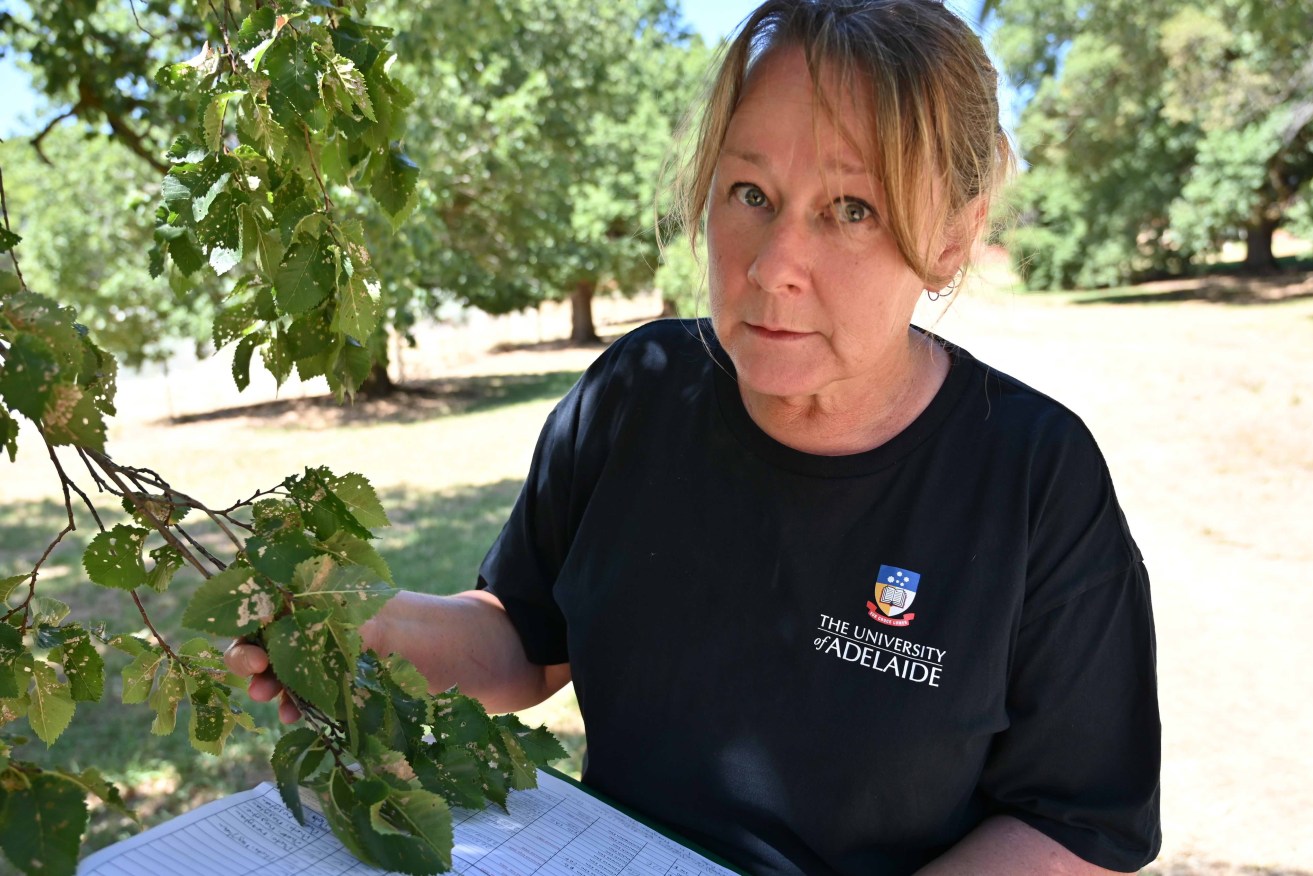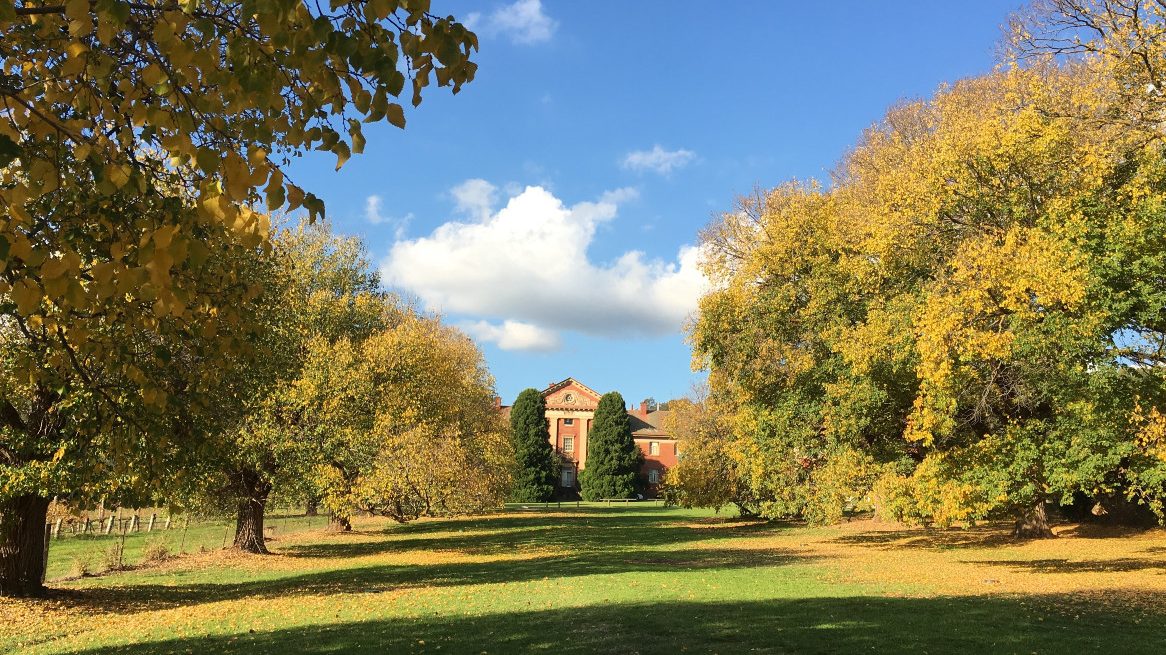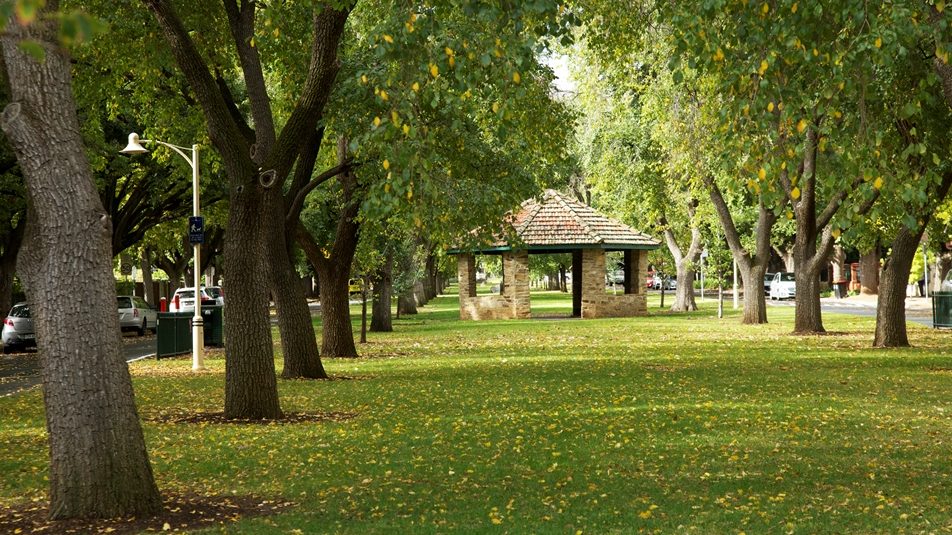Pest beetle threatens to wipe out Adelaide’s Elm trees
Voracious leaf beetles are hitting Waite Arboretum’s 100-year-old Elm Avenue so hard that its caretaker fears she is waging a losing battle to save the much-loved species.

Waite Arboretum curator Dr Kate Delaporte surveys beetle damaged leaves along Elm Avenue. Photo: Belinda Willis
Curator Dr Kate Delaporte wanders along recording damage to the usually splendid avenue of 68 English elms, planted in 1928 to frame the vista from the Waite Institute building to the sea.
On either side of the path are broad-canopied trees recently targeted in a “many thousands of dollars treatment” that are still showing signs of struggle, as Elm Leaf beetles devour their leaves and starve the tree of vital nutrients.
Dr Delaporte says similar attacks are underway across the state as the beetles, first discovered in Adelaide during 2011, build in numbers following an ideal breeding season of mild spring weather.
Beetles are attacking Golden Elms, Dutch Elms and English Elms, and Dr Delaporte fears their growing presence combined with warming weather from climate change may eventually wipe the loved species from the landscape.
Across the state, arborists are working to save them. In Burnside, work is focused on the State Heritage-listed Alexandra Avenue English Elms planted in Rose Park as a memorial to soldiers who lost their lives during World War One.
In the Adelaide Hills, Elm feature trees in high-profile towns are being added to a monitoring and treatment register of more than 150 specimens.
According to Green Adelaide, Elm trees (Ulmus glabra ‘Lutescens’) grown in Australia are some of the most important in the world after populations in Europe and North America were decimated by the Dutch Elm disease from 1910.
At Waite Institute, the State Heritage and National Trust-listed Elm Avenue has been treated with a systemic insecticide that is injected into each tree.
The treatment is designed to course through trunks and branches then into leaves to kill feeding beetles over the next three years.

Waite Arboretum’s heritage-listed Elm Avenue is under attack. Photo: Waite Aborteum
Elm Avenue was treated in 2016 and some trees closest to the Waite Institute building were given a top up last year – but the beetles are not going away.
“The problem is that we need to develop herd immunity,’ Dr Delaporte says.
“If for example 80 per cent of Elms are treated then it will have an impact … but if I’m spending tens of thousands of dollars to treat these trees and the neighbour across the road isn’t then you are fighting a losing battle.”
“If the leaves can’t photosynthesise because they have holes in them from the beetles, the trees will starve to death.”
Volunteers photographed each of the Elm Avenue trees in April last year after a particularly bad infestation and the same will happen this year to make a comparison.
Dr Delaporte said if Elm trees fail to survive it will be a huge loss to the state’s heritage along with the urban canopy.
There are 410 Elms living in the streets and reserves of the City of Burnside, where there are concerns that all are at risk of beetle attacks.
“We are seeing an increase in Elm Leaf Beetle activity this year, as the cooler weather has been a more suitable environment,” chief executive Chris Cowley said, adding that extended hot periods reduced abundance in previous years.
While the council is managing all its trees across the city, particularly care is being given to “one of our most important avenues of English Elm plantations on Alexandra Avenue and Prescott Terrace, which we treat every two years”.
Cowley said the memorial to the Burnside District soldiers is on the State Heritage List.
“The loss of Elms in other countries due to the Dutch Elm Disease further increases the value of these avenues,” he said.
“Other locations that we treat on a two-yearly cycle include Elms on Glynburn Road and in Tusmore Park Reserve.”

Elm trees at the Alexandra Avenue memorial to soldiers are receiving extra help in fighting pest beetles. Photo: City of Burnside
In the Adelaide Hills, locals have raised concerns about the health of a more than 100-year-old weeping Scotch Elm in front of the Stirling Hotel.
Adelaide Hills Council senior arborist Damian Brennan is overseeing a continued response to treat more than 150 high-profile elm trees in his region.
While Brennan has not seen a noticeable increase in beetle activity during the past few years the “long-term future of Elm Leaf Beetle is relatively unknown”.
Brennan said without treatment, damaged caused by the beetle to an Elm tree’s leaf surface reduces its ability to function effectively.
“Consecutive years of high levels of beetle infestation can result in the gradual depletion of a tree’s stored energy supplies, causing tree health decline,” he said, adding that underlying tree health can “determine the trees ability to endure the pest attack.”
At Mount Barker Council a pilot Elm Leaf Beetle program to treat public trees in the district was launched during 2016.
There were 190 trees treated in the first round and another 18 since, with the council saying it is looking to push treatments to five-year cycles.
Stately Elm trees grace parks and gardens across South Australia, including about 80 English Elms forming the graceful curve of the Elm Carriageway from Hutt Street to the South Park Lands/Tuthangga.
These trees were planted by city gardener William O’Brien in the late 1860s reflecting the work of John Ednie Brown, a passionate advocate of tree planting in the mid nineteenth century.
It is this carriageway that led to the inaugural Australian site for Arbor Day, now a national tree planting day.




